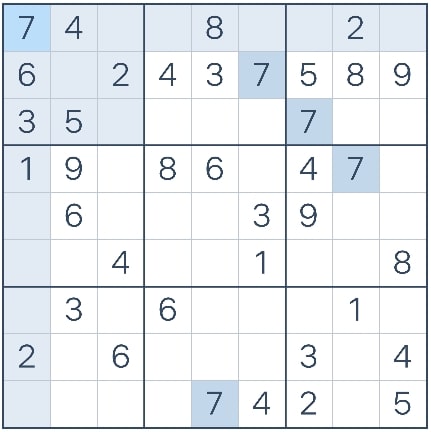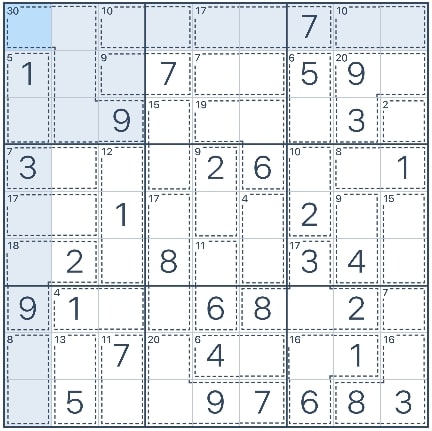Sudoku Rules: A Comprehensive Guide for Beginners
Sudoku is a globally renowned logic-based puzzle game that captivates millions of players with its challenging yet rewarding gameplay. Featuring a simple grid structure packed with intricate possibilities, Sudoku is not only entertaining but also sharpens critical thinking skills. This article provides a detailed explanation of the Sudoku rules, step-by-step gameplay instructions, and helpful tips to help you master this fascinating puzzle. Let’s dive in!
What Is Sudoku?
Sudoku is a logic-based number placement puzzle, typically played on a 9x9 grid. The name "Sudoku" comes from Japanese, meaning "single number" (su = number, doku = single). While it gained popularity in Japan in the 1980s, the concept of Sudoku traces back to logic puzzles from 18th-century Europe and America.
The objective of Sudoku is to fill the grid with numbers from 1 to 9 while adhering to specific rules. No advanced mathematical skills are required—just logical reasoning and patience.
Structure of the Sudoku Grid
Before delving into the rules, let’s break down the structure of a standard Sudoku grid:
- Main Grid: A 9x9 square grid, consisting of 81 individual cells.
- 3x3 Regions: The 9x9 grid is divided into 9 smaller 3x3 sub-grids (often called regions or boxes).
- Rows and Columns: The grid has 9 horizontal rows and 9 vertical columns.
Some cells in the grid are pre-filled with numbers from 1 to 9, known as clues or given numbers. The player’s task is to fill in the empty cells based on these clues.

Sudoku Rules Explained
The rules of Sudoku are straightforward but require careful attention to detail. Here are the core rules:
1. Use Numbers 1 to 9
Each empty cell in the grid must be filled with a number from 1 to 9. No other numbers or symbols (e.g., 0 or letters) are allowed.
2. No Repeated Numbers in Rows
Each horizontal row (9 cells) must contain all numbers from 1 to 9 exactly once, with no duplicates. For example, if a row already contains the number 5, you cannot place another 5 in that row.
3. No Repeated Numbers in Columns
Similarly, each vertical column (9 cells) must include all numbers from 1 to 9 without repetition. If a column already has a 7, no other cell in that column can contain a 7.
4. No Repeated Numbers in 3x3 Regions
Each 3x3 region (containing 9 cells) must also include all numbers from 1 to 9, with no duplicates. If a 3x3 region already has a 2, you cannot place another 2 in that region.
5. Respect the Given Clues
The pre-filled numbers (clues) are fixed and cannot be changed. They serve as starting points to help you solve the puzzle.
6. Complete the Grid
The game is complete when all 81 cells are filled correctly, adhering to the rules above. A properly solved Sudoku grid will have no duplicate numbers in any row, column, or 3x3 region.
Figure 2: Example of a fully solved Sudoku grid
Step-by-Step Guide to Solving Sudoku
Here’s a beginner-friendly guide to solving a Sudoku puzzle:
- Analyze the Clues: Start by examining the given numbers and identifying cells that can be filled immediately based on the no-repetition rule.
- Look for Obvious Cells: Find cells with only one possible number (based on the numbers already present in the row, column, and region). For instance, if a cell can only be 4 (because all other numbers are already used in its row, column, or region), fill in 4.
- Use Elimination: Rule out numbers that cannot appear in a cell based on the numbers in its row, column, or region.
- Take Notes (Optional): For cells with multiple possible numbers, jot down small notes (called “pencil marks”) to track possibilities. Narrow these down as you progress.
- Repeat and Verify: Continue filling cells and double-check your work to ensure no rules are violated. If you hit a dead end, backtrack and try a different approach.
Tips for Playing Sudoku Effectively
- Focus on Frequent Numbers: Identify numbers that appear most often in the clues (e.g., if 5 appears 6 times). This can help you quickly spot where to place that number.
- Prioritize Near-Complete Regions: If a 3x3 region is missing only 1 or 2 numbers, focus on filling those first.
- Check Regularly: After placing a number, verify the row, column, and region to catch mistakes early.
- Be Patient: Sudoku rewards persistence. If you’re stuck, take a break and revisit the puzzle with fresh eyes.
Read more: Sudoku tips and tricks: A Comprehensive Guide from Beginner to Advanced
Sudoku Variations
Beyond the standard 9x9 grid, Sudoku has several exciting variations:
- Sudoku 4x4: A smaller grid using numbers 1 to 4, ideal for kids or beginners.
- Sudoku 16x16: A larger grid with numbers 1 to 16 or letters, increasing the challenge.
-
Sudoku Killer: Combines Sudoku with math, requiring players to fill cells so that groups of cells sum to specific totals.

Example of a Sudoku Killer grid with sum constraints. - Sudoku Samurai: Features five overlapping 9x9 grids, creating a highly complex puzzle.
Conclusion
Sudoku is a fantastic game for exercising your brain and unwinding. Its simple rules paired with endless complexity make it accessible yet deeply engaging for players of all levels. Grab a pencil, a Sudoku grid, and start solving today! Play Sudoku free now
Are you ready to tackle Sudoku? Share your thoughts, favorite strategies, or questions in the comments below!